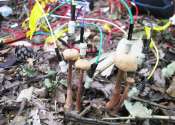Three tips on how to distinguish an edible mushroom from a poisonous one
Served fresh or fried, lots of wild mushrooms go from forest to the table—but know which ones are safe when harvesting this summertime delicacy.

Served fresh or fried, lots of wild mushrooms go from forest to the table—but know which ones are safe when harvesting this summertime delicacy.
Plants & Animals
Jul 12, 2018
0
8

(PhysOrg.com) -- Japanese farming folklore has it that lightning makes mushrooms multiply, and new research supports the idea. Mushrooms form a staple part of the diet in Japan, and the fungi are in such high demand that ...

Psychedelic mushrooms likely developed their "magical" properties to trip up fungi-munching insects, suggests new research.
Evolution
Feb 27, 2018
1
1279

Cultivating mushrooms produces a lot of waste. For every kilogram of mushrooms produced, about three kilograms of soil-like material containing straw, manure and peat is left behind. In the EU, this results in more than 3 ...
Environment
Nov 18, 2020
4
669

According to a new study led by Steeve Bonneville from the Université libre de Bruxelles, the first mushrooms evolved on Earth between 715 and 810 million years ago, 300 million years earlier than the scientific community ...
Plants & Animals
Jan 22, 2020
0
3915

In the Netherlands you can keep helping the planet after you die—by opting for a living coffin made of mushrooms which speeds up the decomposition of your body.
Other
Sep 17, 2020
4
1672

In 1840, renowned English botanist George Gardner reported a strange sight from the streets of Vila de Natividade in Brazil: A group of boys playing with a glowing object that turned out to be a luminescent mushroom. They ...
Plants & Animals
Jul 6, 2011
7
1

Certain fungi play a critical role in the ecological sustenance of forest trees. Ectomycorrhizal fungi are one such example. Commonly found on pine, oak, and birch trees, ectomycorrhizal fungi form a sheath around the outside ...
Plants & Animals
Apr 28, 2023
1
3143

A team of researchers in Penn State's College of Agricultural Sciences has identified a compound in white button mushrooms that could potentially benefit gut health in mammals by activating a protective biological response.
Biochemistry
Aug 17, 2023
0
208

Sing it with us: What lives in the rainforest, under a tree?
Plants & Animals
Jun 15, 2011
0
0
A mushroom is the fleshy, spore-bearing fruiting body of a fungus, typically produced above ground on soil or on its food source. The standard for the name "mushroom" is the cultivated white button mushroom, Agaricus bisporus; hence the word "mushroom" is most often applied to those fungi (Basidiomycota, Agaricomycetes) that have a stem (stipe), a cap (pileus), and gills (lamellae, sing. lamella) or pores on the underside of the cap.
"Mushroom" describes a variety of gilled fungi, with or without stems, and the term is used even more generally, to describe both the fleshy fruiting bodies of some Ascomycota and the woody or leathery fruiting bodies of some Basidiomycota, depending upon the context of the word.
Forms deviating from the standard morphology usually have more specific names, such as "puffball", "stinkhorn", and "morel", and gilled mushrooms themselves are often called "agarics" in reference to their similarity to Agaricus or their place Agaricales. By extension, the term "mushroom" can also designate the entire fungus when in culture; the thallus (called a mycelium) of species forming the fruiting bodies called mushrooms; or the species itself.
This text uses material from Wikipedia, licensed under CC BY-SA